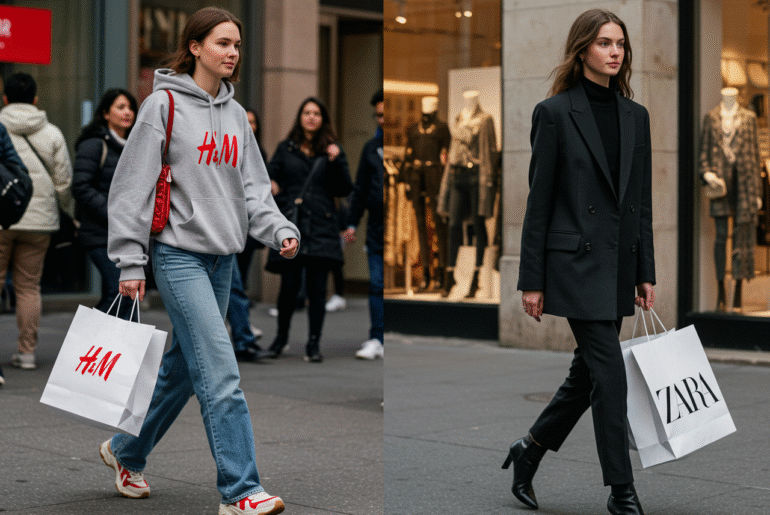This article may contain references to products or services from one or more of our advertisers or partners. We may receive compensation when you click on links to those products or services. Nonetheless, our opinions are our own.
The information presented in this article is accurate to the best of our knowledge at the time of publication. However, information is subject to change, and no guarantees are made about the continued accuracy or completeness of this content after its publication date.
- H&M vs. Zara: Guide to Fast Fashion Choices
- Introduction
- Fast Fashion: H&M and Zara at a Glance
- The Rise of Fast Fashion in the United States
- What Sets H&M and Zara Apart?
- Differences in Business Models
- Design and Production Approaches
- Supply Chain and Speed to Market
- Comparison Table
- How to Choose Between H&M and Zara
- What You’ll Need to Get Started: Budget, Style Preferences, and Shopping Goals
- Guide to Making Your Choice
- Conclusion
- Frequently Asked Questions
- Recommended Reads
H&M vs. Zara: Guide to Fast Fashion Choices
- H&M and Zara are leading global fast fashion retailers offering trendy clothing at accessible prices.
- H&M appeals to cost-conscious shoppers and promotes sustainability through its “Conscious Collection.”
- Zara uses a rapid supply chain and higher-quality fabrics to deliver runway-inspired fashion at a premium price.
- Each brand has a distinct business model, targeting different consumer preferences.
- Their unique approaches to design, supply chain, and environmental responsibility make both brands key players in fast fashion.
- Understanding each brand’s strengths helps shoppers choose based on style, values, and budget.
Introduction
Fast fashion has transformed how consumers shop for clothing. Among the most recognizable names in this industry are H&M and Zara. Both brands attract shoppers with fashionable styles at competitive prices. H&M is known for affordability and environmental efforts, making it appealing across age groups and demographics. Zara, by contrast, is known for trend-driven designs, higher price points, and better-quality materials.
This comparison explores what sets these two fast fashion powerhouses apart and helps shoppers decide which aligns best with their style, values, and budget.
Fast Fashion: H&M and Zara at a Glance
Fast fashion refers to how brands quickly produce and distribute new clothing styles to meet current trends. H&M and Zara excel in this model, consistently offering fresh, affordable fashion. Their ability to refresh stock frequently ensures shoppers always encounter something new.
H&M specializes in affordable basics and eco-conscious options. Its initiatives, like the “Conscious Collection” and garment recycling programs, aim to reduce environmental impact.
Zara caters to fashion-forward customers who prioritize the latest styles. Inspired by runway trends, Zara’s pieces are often more refined in both fabric and design, justifying their higher price.
Both brands succeed with different strategies, offering consumers versatile options based on individual needs and preferences.
The Rise of Fast Fashion in the United States
Fast fashion has gained popularity in the U.S. due to affordability and quick turnaround on new styles. Brands like H&M and Zara thrive in this environment, offering trend-focused clothing at prices that resonate with American consumers.
Zara is distinguished by its flagship stores and luxurious in-store experience, drawing high foot traffic in major cities. H&M, meanwhile, maintains low prices and frequently promotes sales. It has expanded beyond clothing to include accessories and beauty products, increasing its appeal.
Asian fashion influences, particularly from Japan and China, have also shaped fast fashion trends in the U.S., prompting brands to adapt swiftly through optimized supply chains. This flexibility keeps both brands competitive in the ever-changing U.S. retail landscape.
What Sets H&M and Zara Apart?
While both brands operate in the fast fashion space, their strategies differ. H&M focuses on offering affordable, everyday basics, with widespread store availability and frequent sales.
Zara, in contrast, prioritizes trendiness and style exclusivity. New collections are introduced nearly every week, offering a high-end shopping experience in centrally located stores.
These distinct strategies allow both brands to cater to different market segments. H&M is ideal for budget-conscious consumers, while Zara appeals to those seeking fashion-forward options.
Differences in Business Models
H&M and Zara operate with different supply chain strategies. H&M relies on a global supply chain with production primarily in Bangladesh and China. This model keeps costs low but slows down trend adoption, often requiring several months to bring new styles to market.
Zara’s supply chain is more centralized, with manufacturing near its headquarters in Spain. This allows the brand to produce and distribute new designs in just two to three weeks, enabling rapid response to emerging trends.
These approaches serve different consumer priorities. H&M emphasizes affordability and accessibility, while Zara focuses on speed, exclusivity, and style agility.
Voted "Best Overall Budgeting App" by Forbes and WSJ
Monarch Money helps you budget, track spending, set goals, and plan your financial future—all in one app.
Get 50% OFF your first year with code MONARCHVIP
Design and Production Approaches
Design and production are central to how each brand delivers value.
Zara emphasizes high fashion by mimicking runway trends using better-quality materials. The brand is known for frequent new releases and collections that feel current and sophisticated.
H&M prioritizes affordability by using cost-effective materials like polyester. While H&M refreshes its inventory less frequently, it offers a balance of staples and trendy items at a lower price point.
Zara suits consumers seeking stylish, polished looks, while H&M is ideal for shoppers who want affordable, versatile wardrobe basics.
Supply Chain and Speed to Market
Efficient supply chains help brands stay competitive in fast fashion.
Zara’s centralized logistics center in Spain allows it to replenish stores with new items twice per week. This model enables Zara to maintain up-to-date collections and quickly meet consumer demand.
H&M’s decentralized production in Asia results in longer lead times, often taking four to six months to bring new styles to stores. However, this slower pace helps keep prices low and inventory costs manageable.
Comparison Table
| Feature | Zara (Inditex) | H&M (Hennes & Mauritz AB) |
|---|---|---|
| Company Name | Zara (part of Inditex) | H&M (Hennes & Mauritz AB) |
| Headquarters | Arteixo, Galicia, Spain | Stockholm, Sweden |
| Founded | 1975 | 1947 |
| Founder(s) | Amancio Ortega and Rosalía Mera | Erling Persson |
| Key Products | Clothing, accessories, shoes, beauty, home goods | Clothing, accessories, shoes, cosmetics, home goods |
| Business Model | “Fast Fashion” pioneer: Known for quickly replicating high-fashion designs and bringing them to stores in a brief time (often less than two weeks). The company operates an integrated supply chain. | Fast Fashion: Focuses on trendy and affordable clothing. |
| Supply Chain | Highly integrated, with a significant portion of manufacturing (around 60%) close to headquarters in Spain, Portugal, and North Africa for quick turnaround. | More diversified supply chain, with production primarily in Asia and Europe. |
| Design Process | Trends are identified and designs are produced rapidly based on customer demand and catwalk styles. | Design teams create collections based on trends and market analysis. |
| Market Position | One of the world’s largest apparel retailers, known for its rapid trend adoption and response to demand. | One of the world’s largest fashion retailers, known for offering fashion and quality at the best price in a sustainable way. |
| Store Count | Thousands of stores worldwide (as part of Inditex’s brands). | Thousands of stores worldwide (including other H&M Group brands). |
| Sustainability | Increasing focus on sustainability initiatives, including more sustainable materials and collection programs. | Strong emphasis on sustainability, circular fashion, and ethical production. |
| Target Market | Broad appeal, but often perceived as slightly more “fashion-forward” and sophisticated than some competitors. | Broad appeal, offering fashion for men, women, teenagers, and children. |
Zara offers rapid access to the latest trends. H&M, while slower, provides consistent value for everyday shoppers.
How to Choose Between H&M and Zara
Choosing between H&M and Zara depends on your personal preferences, budget, and fashion goals.
Start by considering your needs. Are you looking for wardrobe basics or the latest styles? H&M is great for essentials at low prices. Zara offers trend-focused designs updated weekly.
Next, compare quality and cost. H&M’s items are generally cheaper but made with lower-cost materials. Zara products often feel more premium and stylish, justifying a higher price point.
Evaluate convenience. Do you have easier access to an H&M or Zara store? Both brands also offer reliable online shopping experiences.
Test both brands by exploring their online stores or visiting physical locations. This will help you understand which brand fits your lifestyle and wardrobe needs.
What You’ll Need to Get Started: Budget, Style Preferences, and Shopping Goals
Before shopping at H&M or Zara, consider the following:
- Budget: Are you seeking low-cost fashion or willing to invest in higher-quality pieces?
- Style Preferences: Do you prefer timeless, casual styles or runway-inspired trends?
- Shopping Goals: Are you buying for everyday use, or are you looking for standout pieces and fashion statements?
Answering these questions helps identify which brand aligns better with your priorities.
Guide to Making Your Choice
- Assess Your Wardrobe Needs
Identify whether you need basics or trendy statement pieces. - Evaluate Price and Quality
Determine whether affordability or fabric quality matters more to you. - Review Brand Sustainability Values
Consider which brand aligns more closely with your values on sustainability. - Compare Shopping Experience
Choose between Zara’s upscale in-store design or H&M’s broad accessibility and simplicity.
Conclusion
Choosing between H&M and Zara depends on personal style, budget, and values. H&M excels in affordability and sustainability initiatives like the “Conscious Collection.” Zara stands out with trend-setting designs, quick turnaround, and upscale appeal.
Both brands offer strong advantages. Shoppers can feel confident knowing that either choice provides fashionable options tailored to different needs and lifestyles.
Frequently Asked Questions
Is Zara more expensive than H&M in the US?
Yes, Zara typically costs more than H&M. Zara uses higher-quality fabrics and focuses on trend-based collections, whereas H&M emphasizes affordability.
Which brand is more sustainable: H&M or Zara?
H&M leads in sustainability with its “Conscious Collection,” which uses recycled and eco-friendly materials. Zara has sustainability goals for 2025 but faces criticism for its rapid production model.
Where can I find the best sales for H&M and Zara?
H&M frequently offers sales both online and in stores. Zara has fewer promotions, but deals can be found in larger stores during clearance events.
Are H&M and Zara clothes true to size?
Generally, both brands follow standard sizing, but fit can vary by item. It’s best to consult online sizing guides or try clothes on in-store before purchase.

Reviewed and edited by Albert Fang.
See a typo or want to suggest an edit/revision to the content? Use the contact us form to provide feedback.
At FangWallet, we value editorial integrity and open collaboration in curating quality content for readers to enjoy. Much appreciated for the assist.
Did you like our article and find it insightful? We encourage sharing the article link with family and friends to benefit as well - better yet, sharing on social media. Thank you for the support! 🍉
Article Title: HandM vs Zara: Guide to Fast Fashion Choices
https://fangwallet.com/2025/06/11/hm-vs-zara/The FangWallet Promise
FangWallet is an editorially independent resource - founded on breaking down challenging financial concepts for anyone to understand since 2014. While we adhere to editorial integrity, note that this post may contain references to products from our partners.
The FangWallet promise is always to have your best interest in mind and be transparent and honest about the financial picture.
Become an Insider

Subscribe to get a free daily budget planner printable to help get your money on track!
Make passive money the right way. No spam.
Editorial Disclaimer: The editorial content on this page is not provided by any of the companies mentioned. The opinions expressed here are the author's alone.
The content of this website is for informational purposes only and does not represent investment advice, or an offer or solicitation to buy or sell any security, investment, or product. Investors are encouraged to do their own due diligence, and, if necessary, consult professional advising before making any investment decisions. Investing involves a high degree of risk, and financial losses may occur including the potential loss of principal.
Source Citation References:
+ Inspo
There are no additional citations or references to note for this article at this time.












































